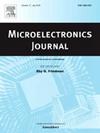具有高效节能的双向延迟产生的13位4MS/s SAR ADC
IF 1.9
3区 工程技术
Q3 ENGINEERING, ELECTRICAL & ELECTRONIC
引用次数: 0
摘要
本文提出了一种用于异步连续逼近寄存器(SAR)模数转换器(ADC)的双向延迟产生方案,该方案实现了低功耗和宽延迟范围。所提出的基于逆变器的延迟电路在供电轨(VDD和地)上都采用了多电阻,从而最小化负载电容,同时延长了可实现的延迟范围。与需要重置阶段的传统单向充电方案不同,所提出的双向充放电技术重用存储的电荷,减少了能量开销,并支持多种延迟配置。这些模式在SAR转换周期内动态应用,确保稳定的CDAC沉降和节能的比较器时钟。为了验证所提出的方案,在65 nm LP CMOS工艺中实现了一个13位SAR ADC,功耗为59.3 μW,速度为4 MS/s。双向延迟电路仅占总功率的2%,而比较器时钟发生器占用ADC面积的3%,显示出最小的开销。该原型实现了73 dB的SNDR和4.1 fJ/转换步长的瓦尔登优值(FoMW),使其与需要纳秒级延迟产生的最先进的SAR adc竞争。本文章由计算机程序翻译,如有差异,请以英文原文为准。
A 13 bit 4MS/s SAR ADC with energy-efficient bidirectional delay generation
This paper presents a bidirectional delay generation scheme for an asynchronous successive approximation register (SAR) analog-to-digital converter (ADC), achieving both low power consumption and a wide delay range. The proposed inverter-based delay circuit incorporates poly resistors at both supply rails ( and ground), minimizing load capacitance while extending the achievable delay range. Unlike conventional unidirectional charging schemes that require a reset phase, the proposed bidirectional charging and discharging technique reuses stored charge, reducing energy overhead and enabling multiple delay configurations. These modes are dynamically applied within the SAR conversion cycle, ensuring stable CDAC settling and energy-efficient comparator clocking. To validate the proposed scheme, a 13 bit SAR ADC was implemented in a 65-nm LP CMOS process, consuming 59.3 W at 4 MS/s. The bidirectional delay circuit accounts for only 2% of total power, while the comparator clock generator occupies 3% of ADC area, demonstrating minimal overhead. The prototype achieves an SNDR of 73 dB and a Walden figure of merit (FoM) of 4.1 fJ/conversion-step, making it competitive with state-of-the-art SAR ADCs requiring nanosecond-level delay generation.
求助全文
通过发布文献求助,成功后即可免费获取论文全文。
去求助
来源期刊

Microelectronics Journal
工程技术-工程:电子与电气
CiteScore
4.00
自引率
27.30%
发文量
222
审稿时长
43 days
期刊介绍:
Published since 1969, the Microelectronics Journal is an international forum for the dissemination of research and applications of microelectronic systems, circuits, and emerging technologies. Papers published in the Microelectronics Journal have undergone peer review to ensure originality, relevance, and timeliness. The journal thus provides a worldwide, regular, and comprehensive update on microelectronic circuits and systems.
The Microelectronics Journal invites papers describing significant research and applications in all of the areas listed below. Comprehensive review/survey papers covering recent developments will also be considered. The Microelectronics Journal covers circuits and systems. This topic includes but is not limited to: Analog, digital, mixed, and RF circuits and related design methodologies; Logic, architectural, and system level synthesis; Testing, design for testability, built-in self-test; Area, power, and thermal analysis and design; Mixed-domain simulation and design; Embedded systems; Non-von Neumann computing and related technologies and circuits; Design and test of high complexity systems integration; SoC, NoC, SIP, and NIP design and test; 3-D integration design and analysis; Emerging device technologies and circuits, such as FinFETs, SETs, spintronics, SFQ, MTJ, etc.
Application aspects such as signal and image processing including circuits for cryptography, sensors, and actuators including sensor networks, reliability and quality issues, and economic models are also welcome.
 求助内容:
求助内容: 应助结果提醒方式:
应助结果提醒方式:


